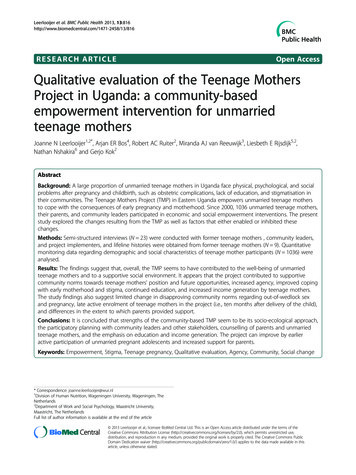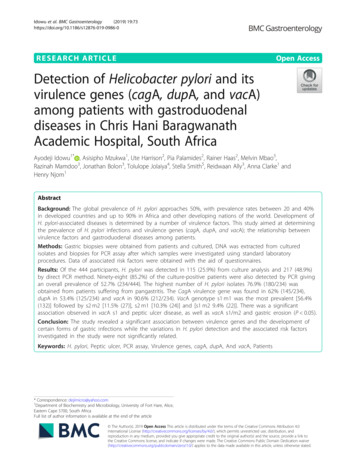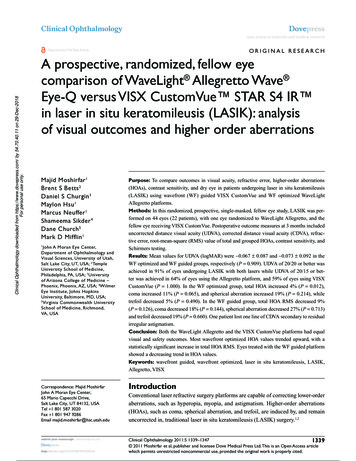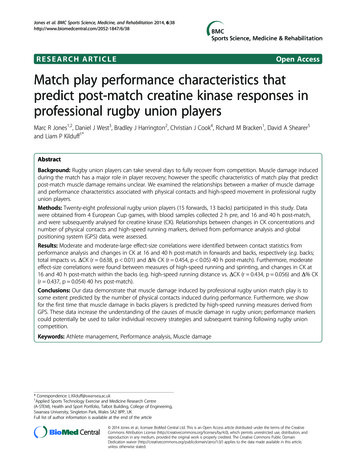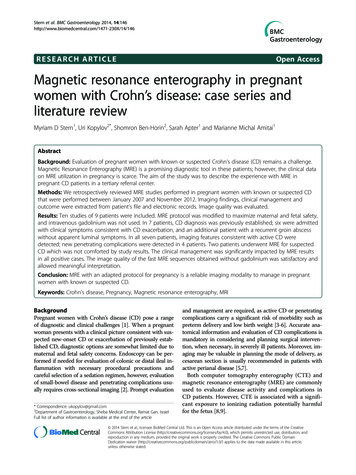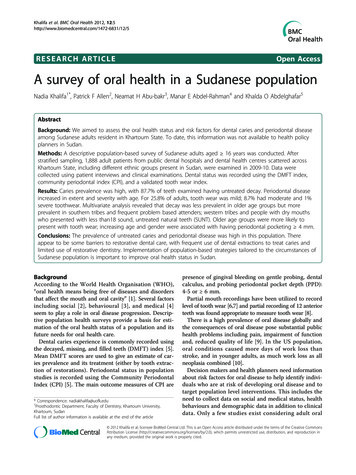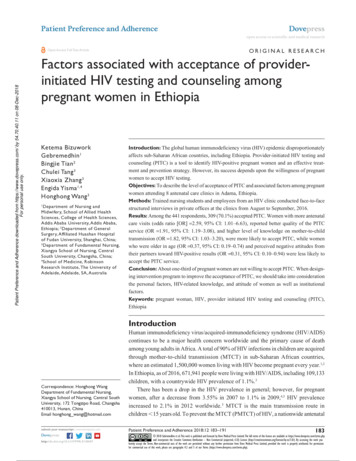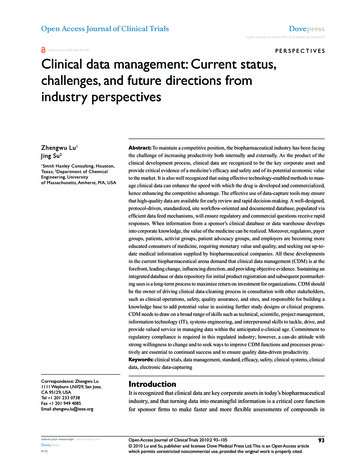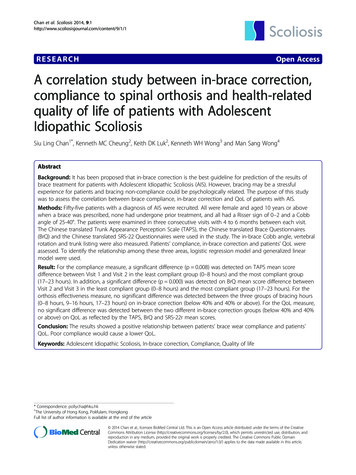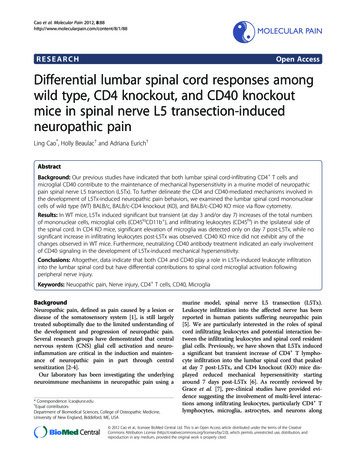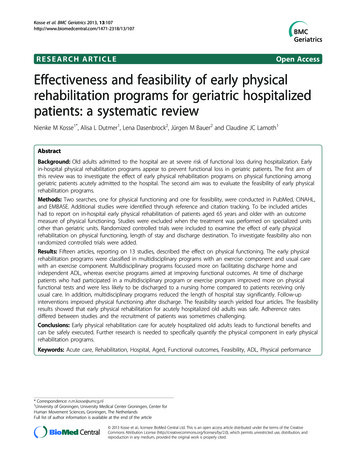
Transcription
Kosse et al. BMC Geriatrics 2013, 7RESEARCH ARTICLEOpen AccessEffectiveness and feasibility of early physicalrehabilitation programs for geriatric hospitalizedpatients: a systematic reviewNienke M Kosse1*, Alisa L Dutmer1, Lena Dasenbrock2, Jürgen M Bauer2 and Claudine JC Lamoth1AbstractBackground: Old adults admitted to the hospital are at severe risk of functional loss during hospitalization. Earlyin-hospital physical rehabilitation programs appear to prevent functional loss in geriatric patients. The first aim ofthis review was to investigate the effect of early physical rehabilitation programs on physical functioning amonggeriatric patients acutely admitted to the hospital. The second aim was to evaluate the feasibility of early physicalrehabilitation programs.Methods: Two searches, one for physical functioning and one for feasibility, were conducted in PubMed, CINAHL,and EMBASE. Additional studies were identified through reference and citation tracking. To be included articleshad to report on in-hospital early physical rehabilitation of patients aged 65 years and older with an outcomemeasure of physical functioning. Studies were excluded when the treatment was performed on specialized unitsother than geriatric units. Randomized controlled trials were included to examine the effect of early physicalrehabilitation on physical functioning, length of stay and discharge destination. To investigate feasibility also nonrandomized controlled trials were added.Results: Fifteen articles, reporting on 13 studies, described the effect on physical functioning. The early physicalrehabilitation programs were classified in multidisciplinary programs with an exercise component and usual carewith an exercise component. Multidisciplinary programs focussed more on facilitating discharge home andindependent ADL, whereas exercise programs aimed at improving functional outcomes. At time of dischargepatients who had participated in a multidisciplinary program or exercise program improved more on physicalfunctional tests and were less likely to be discharged to a nursing home compared to patients receiving onlyusual care. In addition, multidisciplinary programs reduced the length of hospital stay significantly. Follow-upinterventions improved physical functioning after discharge. The feasibility search yielded four articles. The feasibilityresults showed that early physical rehabilitation for acutely hospitalized old adults was safe. Adherence ratesdiffered between studies and the recruitment of patients was sometimes challenging.Conclusions: Early physical rehabilitation care for acutely hospitalized old adults leads to functional benefits andcan be safely executed. Further research is needed to specifically quantify the physical component in early physicalrehabilitation programs.Keywords: Acute care, Rehabilitation, Hospital, Aged, Functional outcomes, Feasibility, ADL, Physical performance* Correspondence: n.m.kosse@umcg.nl1University of Groningen, University Medical Center Groningen, Center forHuman Movement Sciences, Groningen, The NetherlandsFull list of author information is available at the end of the article 2013 Kosse et al.; licensee BioMed Central Ltd. This is an open access article distributed under the terms of the CreativeCommons Attribution License (http://creativecommons.org/licenses/by/2.0), which permits unrestricted use, distribution, andreproduction in any medium, provided the original work is properly cited.
Kosse et al. BMC Geriatrics 2013, 7BackgroundThe rapidly growing population of old adults in Westerncountries has become a major concern for health caresystems. Due to a poorer health status, old adults consume a disproportionate amount of medical care. Insome European countries, more than 40% of patients admitted to the hospital for an overnight stay are aged65 years and older, while their total share of the population is less than 20% [1].Unfortunately, old adults admitted to the hospital areat severe risk of functional decline, both during hospitalization and after discharge [2,3]. A number of studiesfound that approximately 33% of the patients have severe functional deterioration at time of discharge compared to their status before hospital admission [3-5]. Forpatients 90 years or older this number even increases to63% [4]. Functional decline during and after hospital stayhas shown to be an important risk factor for nursinghome placement [6,7].The decline in functional capacity seems to be partlythe result of the hospitalization itself, unrelated to diagnostic or therapeutic interventions. Older patients havedecreased physiological and functional reserves thatmake them more vulnerable to the effects of bed restand decrease in dietary intake, which both are highlyprevalent during hospitalization. Due to immobilisation,muscle strength and aerobic capacity tend to declinerapidly. After only ten days of bed rest healthy old adultslose 12-14% of both their VO2max and lower extremitymuscle strength [8]. Without any voluntary muscle contractions muscle strength can even decrease by 5% perday [2].Altogether, functional decline is a common problemthat is significantly associated with negative outcomessuch as institutionalization, re-hospitalization and subsequent mortality [3]. The primary focus of hospital care istreating acute and chronic illnesses. A physical rehabilitation intervention that may preserve physical functionis often not part of the treatment. To preclude a rapiddecline in physical function it is important that hospitalprograms are also directed explicitly towards activatingthe older patient early after hospital admission. Earlyphysical rehabilitation might help to prevent decline inphysical functioning arising from immobility and prolonged bed rest [9].Over the years, several multidisciplinary and exercisetypes of early rehabilitation interventions have been studied. Previous studies showed that early rehabilitation programs improved both patient (e.g. physical functioning)and hospital outcomes (e.g. reducing costs) for acute illgeriatric patients [10,11]. However, an important issue notyet addressed in the current literature is the feasibility ofin-hospital early exercise programs for acute geriatric patients. To start an early physical rehabilitation program,Page 2 of 16knowledge of which patient population benefit from theprogram is required. Furthermore, it is important to knowif there will be adverse events during early physical rehabilitation programs in terms of falls or other injuriesand what the adherence rate of the patients will be duringthe treatment sessions. Therefore, the first aim of this review is to evaluate the effects of early physical rehabilitation programs on physical functioning of geriatric patientsacutely admitted to a hospital. In this review early physicalrehabilitation in acutely ill patients refers to physical therapy, occupational therapy, and physical exercises initiatedimmediately upon achieving physiologic stability and continued throughout the hospital stay. Such activities startwithin 1 or 2 days after hospitalization. The second aim ofthe present review is to evaluate the feasibility of earlyphysical rehabilitation programs in the hospitalized geriatric patients.MethodSearch strategyA systematic literature search was conducted in threeelectronic databases, PubMed, CINAHL, and EMBASE inAugust 2013. Keywords used to perform the search were:“aged” or “elderly” or “geriatric”, “hospital” or “hospitalized”, “exercise” or “rehabilitation”, “ADL” or “physicalfunctioning” or “mobility” or “physical performance”, and“acute” or “acutely”. The articles included were randomized controlled trials (RCT), written in English, includingparticipants aged 65 years or older who were acutely admitted to the hospital. The interventions investigated inthe articles needed to include a physical exercise part witha physical functioning measure as outcome. Studies wereexcluded if the included patients required treatment on aspecialized unit other than an acute geriatric unit or whenthe evaluated intervention aimed at a specific disorder orsurgical process. Articles about the feasibility of earlyphysical rehabilitation of inpatients were retrieved byadding the keywords “feasibility” or “feasible” or “adherence rate” or “safety” to the keywords mentioned above.The articles about feasibility had the same in and exclusion criteria as the articles addressing physical functioningwith the exception that also non randomized controlledtrials were included. For the inclusion process title and abstract were examined and when necessary the full articlewas obtained and read. Additional studies were identifiedthrough reference and citation tracking. Two reviewersindependently screened title, abstract and full text. Disagreement about inclusion of articles was resolved by discussion and consensus between the two reviewers.Data extraction and analysisData were extracted against pre-defined categories bytwo researchers. The data compiled from the studies included information on: study design, characteristics of
Kosse et al. BMC Geriatrics 2013, 7participants and setting, the intervention and controlgroup treatment, time of assessment, ADL, physical performance, length of stay and discharge destination. Furthermore, the feasibility outcomes were the ability toenrol patients into the rehabilitation program, and theadherence rate and safety of the patients during the therapy sessions. The information extracted from the articleswas organized into tables and systematically compared.Methodological qualityThe methodological quality of the included RCTs wasassessed using the Delphi scale [12]. The Delphi scale isa quality assessment tool for RCTs and has shown to bevalid and reliable [13]. It consists of 9 different criteriawhich can be scored positive, negative, or unclear (“yes”,“no”, and “don’t know”). One point was given for each“yes” and zero points for each “no” or “don’t know”, thetotal quality sore ranged from 0 (low quality) to 9 (highquality).ResultsSelected studiesThe literature search for physical functioning yielded atotal of 772 papers (Figure 1). After removing 765 articles based on title and abstract, 9 articles were qualifiedfor full text reading. Four articles were removed after fulltext reading and ten articles were added after referencechecking. The remaining 15 articles, describing 13 studies, were included to this review. The search for feasibility studies yielded 50 papers. After removing 47 articlesby title, abstract and full text reading and adding one article after reference checking, four studies were includedPage 3 of 16for the feasibility assessment. The article of Laver et al.[14] was included in both the physical functioning and thefeasibility section. PRISMA guidelines were followed inthis systematic review [15].Methodological qualityIn Table 1 the quality scores on the Delphi Scale for thedifferent RCT studies are reported. Total quality scoresranged from 3 to 7 with a median score of 5. The methodological quality was moderate for most studies.Randomization methods and eligibility criteria wereclearly defined in all 13 studies. The studies scored particularly low on blinding the assessor, the care providerand the participant. The Delphi scores were good for theconcealed treatment allocation, the similarity of theintervention and control groups at baseline and the clarity of the specified eligibility criteria.Inclusion criteria and patient characteristicsTable 2 summarizes the characteristics of patients, studysettings, early physical rehabilitation programs and outcomes of the included RCT studies in this review. Themean age for patients admitted to acute care in the hospital for a general medical condition varied between 78and 86 years old. The most common reasons for admission were cardiac problems, respiratory problems,gastrointestinal problems, neurological problems, infections and injuries caused by a fall. The living situation ofthe patients before they were admitted to the hospitalvaried, patients came from nursing homes and othertypes of institutionalised care or from the communitywhere they lived alone or with family. However, theRecords identified throughdatabase searching (n 859)FeasibilityAdditional records identifiedthrough other sources (n 10)IdentificationIdentificationPhysical FunctioningStudies included insynthesis (n 15)Figure 1 Flowcharts of search results.Full-text articles excluded (n 4)Reasons:No exercise part 2No RCT 2ScreeningEligibilityRecords excluded (n 773)IncludedScreeningEligibilityIncludedFull-text articles assessedfor eligibility (n 19)Additional records identifiedthrough other sources (n 1)Records after duplicates removed(n 51)Records after duplicates removed(n 782)Records screened(n 782)Records identified throughdatabase searching (n 57)Records screened(n 51)Full-text articles assessedfor eligibility (n 5)Studies included insynthesis (n 4)Records excluded (n 46)Full-text articles excluded (n 1)Reasons:No acute care 1
Kosse et al. BMC Geriatrics 2013, 7Page 4 of 16Table 1 Methodological quality scores on the Delphi scale for each RCT studyStudyRandomized Treatment Groups Eligibility OutcomeCarePatient Variability Intention-to-treat Totalallocation similar at criteriaassessor provider blinded measuresanalysis(max 9)concealed baseline specified blinded blindedAbizanda [16]1101111107Asplund [17]1111000004Blanc-Bisson [18]1011000115Counsell [19]1111000116Courtney [20,21]1111100117De Morton [22]1001001115Jones [23]1101000115Landefeld [24]1011000003Laver [14]1111100117Nikolaus [25]1111100106Saltvedt [26,27]1111000105Siebens [28]1111000015Slaets [29]1111000004studies did not include all patients in the intervention,reasons for exclusion were medical instability [18,22,23],need for specialized care [17,19,22,24], living in nursinghomes [19,20,22,23,25,26,28], small survival chance orneed for palliative care [18,22,23,25,28], and being diagnosed with an illness causing functional impairment[18,23,28]. Overall, there was a great heterogeneityamong the participants between the different studies.Setting and interventionTable 2 gives an overview of the settings and interventions of each included randomized controlled trial. Thestudies were performed on acute geriatric units, geriatricunits and medical units of university hospitals, city hospitals and acute care hospitals. Early physical rehabilitation programs could be divided into two categories, (1)multidisciplinary programs with an exercise componentand (2) usual care with an additional exercise program.In the review we refer to these categories as multidisciplinary programs and exercise programs, respectively. Themain aim of the multidisciplinary programs was tomaintain or obtain independent ADL and encouragereturning home. Multidisciplinary intervention teamsusually consisted of a geriatrician, (geriatric) nurses, social workers, physical therapists and occupational therapists [17,19,24,26,29]. The specific exercise componentof the multidisciplinary intervention studies is hardly described, and information on intensity, duration, and frequency of exercises is often lacking. Usual care with anadditional exercise program was provided in eight studies [14,16,18,20,22,23,25,28]. The patients in the exerciseprograms were supervised by allied health assistants, aphysiotherapist or an occupational therapist. Patientsperformed exercises five times a week up to twice daily.The aim of the exercise programs was predominantly toimproving functional outcomes by training strength, mobility, and balance. Strength exercises were progressedby increasing the number of sets and repetitions andwalking exercises were progressed in intensity (fromslow to moderate pace) or duration (from 5 to 30 minutes). In one study an interactive video gaming program was used to exercise. A Nintendo Wii fit grouptrained 25 min/day, 5 days/week under supervision of aphysical therapist [14]. Some exercise programs supported participants to continue exercise after discharge[20,25,28]. This was achieved by educational materials,by (two or more regular) encouraging phone calls andhome visits [20,28], or by a follow-up treatment, twice aweek up to twice a day, including physical and occupational therapy [25]. The control groups of the studiesgenerally received usual care according to the generalroutines of the hospital they were admitted to.Physical functioningAll included studies provided at least one outcomemeasure related to physical functioning. Most studiesused measures of activities of daily living (ADL) andphysical performance to describe physical functioning.Additional information about length of stay and discharge destination were also documented.Activities of daily livingThe included studies gained information on patient’sADL by conducting interviews and (self-administered)questionnaires. Table 3 gives on overview of the used instruments to measure (I)ADL. Eleven of the thirteenstudies reported the effects of their intervention on(I)ADL at time of hospital discharge [14,16-19,21-25,29].
StudyPopulation & Setting InterventionTime of assessment(I)ADLPhysicalMortalityPerformance (%)LOSDischarge(days) ICF (%)BI 19 pointsNA5.9*Multidisciplinary care with an exercise componentAsplund 2000 [17]Intervention (n 190)Mean age 80.9 yearsMultidisciplinary team, with physical and occupational T0 Admissiontherapy. Discharge planning and early rehabilitation.T1 Discharge58% female, AGU, UHT2 11.1T1 2.7Mean age 81.0 yearsT0 44%T2 7.663% female, MU, UHT2 43%General medical unit careIntervention (n 767) † Multidisciplinary team, with daily assessment ofphysical functioning and protocols to improveself-care and mobility. Early discharge planning.60% female, CHMean age 80 yearsControl (n 764) †T1 11.6T2 11.6T2 44%BI 19 pointsControl (n 223)Counsell 2000 [19]T2 3 months post-dischargeT0 52%T1 4.27.3*T1 19.3T2 18.4T0 2 weeks pre-admissionADL declinePPME scoreT1 2.7T1 DischargeT1 30%T1 5.6*T2 9.0T2 10.3T2 1 months post-dischargeT2 27%T3 15.9T3 8.9T3 3 months post-dischargeT3 26%T4 22.6T4 7.5T4 6 months post-dischargeT4 22%T5 31.4T5 6.7T5 1 year post-dischargeT5 25%Usual physician and nursing staff care6.1ADL declinePPME scoreT1 3.7Mean age 79 yearsT1 34%T1 5.0*T2 11.3T2 10.161% female, CHT2 29%T3 17.4T3 7.2T4 22.5T4 8.0T3 26%6.3T1 12.9Kosse et al. BMC Geriatrics 2013, 7Table 2 Setting and study characteristics physical functioningT1 15.6T4 30%T5 30%T5 29.2Landefeld 1995 [24]Intervention (n 327)Mean age 80.2 years68% female, MU, CHMultidisciplinary program, with daily assessmentof physical functioning and protocols to improveself-care and mobilityT0 AdmissionADL score:T1 DischargeT0 3.0T2 3 months post-dischargeNAT1 7.3T2 20.8T5 7.37.3T1 5.8*T2 13.1**T1 3.6T2 4.0IADL score:T0 2.8T1 3.3*T2 3.9Page 5 of 16
Control (n 324)Mean age 80.1 yearsUsual care services provided byphysicians and nurses65% female, MU, CHADL score:T1 7.48.3T0 3.0T2 19.8T1 11.7*T2 18.8*T2 3.8IADL score:T0 2.8T2 3.8Saltvedt 2002 [26,27]Intervention (n 127) † Interdisciplinary program to preventcomplications, with early mobilization,Mean age 81.8 yearsrehabilitation and discharge planning81% female, GU, UHT0 AdmissionADL dependenceT1 3 months post-dischargeT1 21%T2 6 months post-dischargeT2 13%T3 1 year post-dischargeNAT1 11.8*15*NA*T3 26.8T3 25%IADL dependenceKosse et al. BMC Geriatrics 2013, 7Table 2 Setting and study characteristics physical functioning (Continued)T1 46%T2 44%T3 45%Control (n 127) †ADL dependenceT1 27.6*Mean age 82.4 yearsT1 12%T2 33.9*84% female, MU, UHT2 13%Usual care7*T3 23%IADL dependenceT1 39%T2 40%T3 44%Slaets 1997 [29
and hospital outcomes (e.g. reducing costs) for acute ill geriatric patients [10,11]. However, an important issue not yet addressed in the current literature is the feasibility of in-hospital early exercise programs for acute geriatric pa-tients. To start an early physical rehabilitation p
